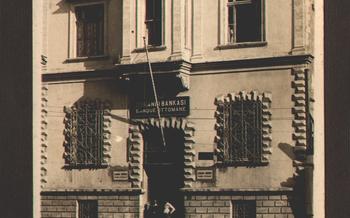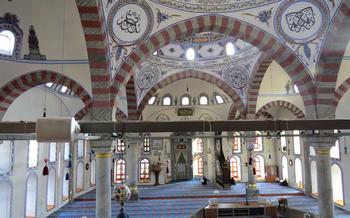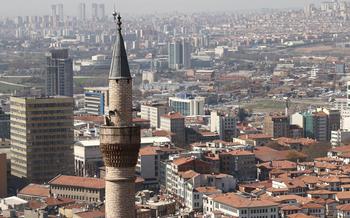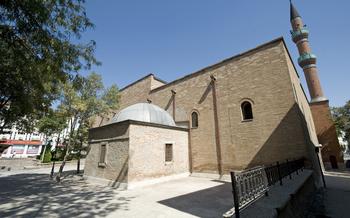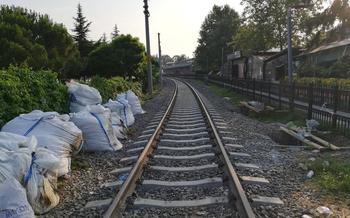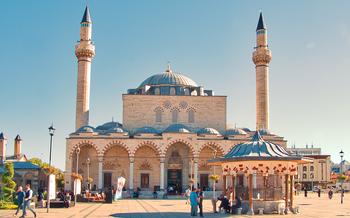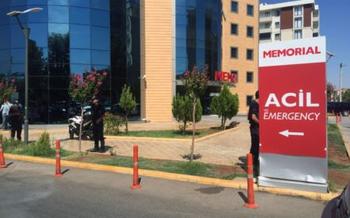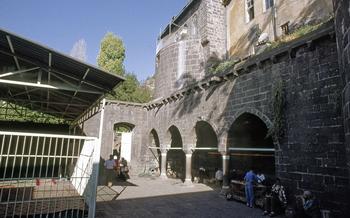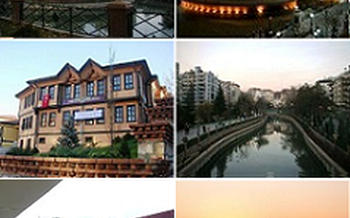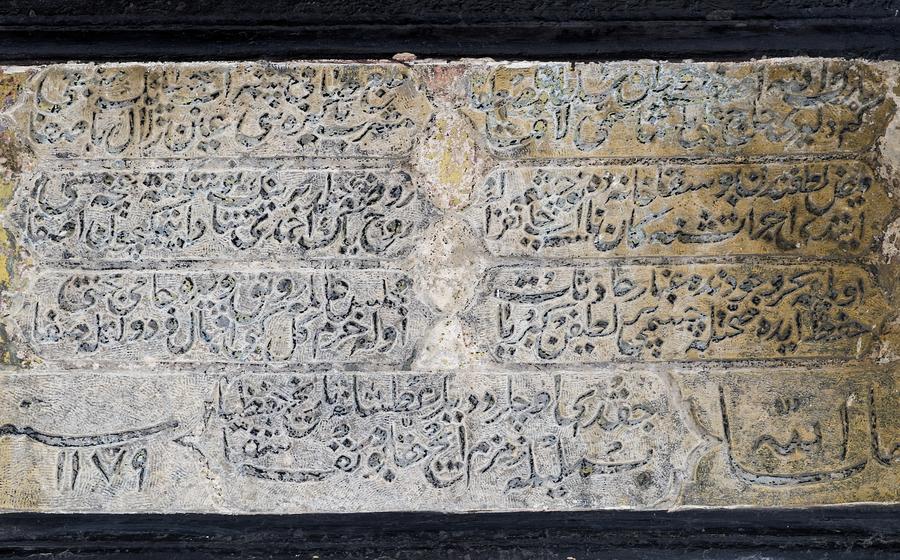
The Grand Mosque of Kütahya
- History of the Grand Mosque of Kütahya
- Architectural Features
- Interior Decorations
- The Courtyard
- Religious Significance
- Cultural Importance
- Tourism Potential
- Visiting the Mosque
- Prayer Times
- Local Customs and Traditions
- Nearby Attractions
- Food and Accommodation
- Safety and Security
- Photography and Videography
- Insider Tip
History of the Grand Mosque of Kütahya
The Grand Mosque that has shaped the city for centuries. Its construction began in 1378, during the reign of the Ottoman Sultan Murad I, and was completed in 1388 under the supervision of the renowned architect Hayreddin. The mosque has witnessed numerous historical events throughout its existence, serving as a place of worship, learning, and community gatherings. Over the centuries, it has undergone several renovations and restoration projects, ensuring its continued grandeur and functionality. In 1973, the mosque was declared a protected historical monument, recognizing its significance as a cultural and architectural masterpiece.
Architectural Features
Size and Dimensions: The Grand Mosque of Kütahya stands as a testament to the grandeur of Islamic architecture. Its vast prayer hall measures an impressive 40 meters in length and 25 meters in width, providing ample space for worshippers to congregate and offer their prayers.
Materials and Construction: Built using locally sourced materials, the mosque showcases the resilience of traditional Anatolian construction techniques. Its sturdy walls are composed of solid stone, while the elegant arches and domes are crafted from meticulously carved sandstone.
Minaret: The mosque's striking minaret, a beacon of faith, rises majestically above the cityscape. Its intricate tilework, featuring geometric patterns and Quranic inscriptions, reflects the artistry and devotion of the builders. The minaret's slender form, reaching towards the heavens, serves as a visual reminder of the connection between the earthly and the divine.
Mihrab: The mihrab, the sacred niche indicating the direction of prayer, is a masterpiece of Islamic design. Carved from a single block of marble, it features intricate floral and geometric motifs that frame the niche. The mihrab's delicate ornamentation and harmonious proportions create a sense of awe and reverence within the prayer hall.
Interior Decorations
The interior of the Grand Mosque of Kütahya is a testament to the artistry and craftsmanship of its builders. The walls are adorned with intricate tilework and calligraphy, creating a symphony of colors and patterns. The mihrab, the niche indicating the direction of Mecca, is a masterpiece of Islamic art, with its finely carved marble and intricate tilework. The stained-glass windows, with their vibrant hues, cast a warm and colorful light into the prayer hall. The marble carvings and sculptures, depicting verses from the Quran and Islamic motifs, add to the mosque's grandeur and spiritual atmosphere. The unique features of the prayer hall, such as its high ceiling and spacious layout, create a sense of awe and tranquility, conducive to prayer and contemplation.
The Courtyard
The courtyard of the Grand Mosque of Kütahya is a serene and inviting space, providing a tranquil oasis amidst the bustling city. Its spacious layout and meticulous landscaping create a welcoming atmosphere for worshippers and visitors alike.
The courtyard, measuring approximately 50 meters in length and 30 meters in width, is enclosed by the mosque's walls and features a central fountain for ablutions. The fountain's gentle flowing water adds a soothing ambiance to the courtyard, while also serving its practical purpose of providing water for ritual cleansing before prayers.
Surrounding the courtyard are beautiful gardens, meticulously maintained with vibrant flowers, lush greenery, and shady trees. These gardens provide a peaceful and picturesque setting, inviting visitors to relax and contemplate amid the tranquility of the mosque's grounds.
The courtyard also plays a significant role in community gatherings. During religious festivals and special occasions, the courtyard is transformed into a lively venue for celebrations and communal activities. Locals gather to share meals, engage in conversations, and strengthen their bonds of friendship and community.
Overall, the courtyard of the Grand Mosque of Kütahya serves not only as a functional space for ablutions and gathering, but also as a place of tranquility, reflection, and community connection.
Religious Significance
As a place of worship, the Grand Mosque of Kütahya holds immense religious significance for the Muslim community. It serves as a central hub for daily prayers, with the Friday prayers holding particular importance. During these weekly congregations, the mosque's spacious prayer hall fills with devout worshippers seeking spiritual guidance and communal connection. The mosque also plays a crucial role in Islamic education, with classes and lectures held to deepen the understanding of religious teachings and practices. Moreover, the mosque serves as a focal point for community gatherings, fostering a sense of unity and togetherness among the local Muslim population. Its presence contributes to the vibrant religious landscape of Kütahya, showcasing the deep-rooted faith and traditions of the city's inhabitants.
Cultural Importance
The Grand Mosque of Kütahya stands as a testament to the rich cultural heritage of Turkey. It has played a pivotal role in preserving Turkish culture and traditions, serving as a center for religious, social, and intellectual exchange. The mosque's intricate architecture, awe-inspiring interiors, and historical significance have made it a symbol of Turkish identity and craftsmanship.
Over the centuries, the mosque has influenced local customs and traditions, shaping the cultural fabric of Kütahya. Its religious teachings and practices have deeply intertwined with the daily lives of the community, fostering a sense of unity and belonging. The mosque has also been instrumental in promoting interfaith dialogue, fostering understanding and cooperation among people of different faiths.
In recent years, the Grand Mosque of Kütahya has become an integral part of cultural heritage tours, attracting visitors from around the world. Its inclusion in these tours highlights its cultural significance and provides a unique opportunity for visitors to learn about Turkish history, architecture, and religion.
Tourism Potential
The Grand Mosque of Kütahya stands as a testament to the city's rich cultural heritage, attracting a steady stream of tourists each year. Its architectural splendor and religious significance make it a must-visit destination for those interested in Islamic architecture and history. The mosque's inclusion in cultural heritage tours further enhances its appeal, providing visitors with a deeper understanding of Turkey's diverse cultural tapestry.
Beyond its cultural significance, the mosque also contributes to the local economy. The influx of tourists generates revenue for the city, supporting local businesses such as restaurants, hotels, and souvenir shops. Employment opportunities are also created for tour guides, transportation providers, and other tourism-related services.
However, managing the influx of tourists while preserving the authenticity and sanctity of the mosque presents a unique challenge. The authorities have taken measures to strike a balance between promoting tourism and ensuring the mosque remains a place of worship and spiritual reflection. This includes implementing regulations for guided tours, enforcing dress codes, and providing information to visitors about appropriate behavior within the mosque.
Despite the challenges, the Grand Mosque of Kütahya continues to captivate visitors with its stunning beauty and spiritual significance, contributing to the city's tourism industry and strengthening its position as a cultural and historical gem of Turkey.
Visiting the Mosque
The Grand Mosque of Kütahya welcomes visitors from all over the world to explore its architectural beauty and spiritual significance. Here are some practical tips for planning your visit:
-
Best time to visit: The mosque is open to visitors daily from 9 am to 5 pm, except during prayer times. The best time to visit is early morning or late afternoon to avoid the crowds and enjoy a more peaceful atmosphere.
-
Dress code and etiquette: Visitors are expected to dress modestly and respectfully when entering the mosque. Women should cover their heads with a scarf or headscarf, and both men and women should avoid wearing shorts or sleeveless shirts. It is also essential to maintain silence and avoid disturbing those who are praying.
-
Guided tours: Guided tours of the mosque are available upon request and can be arranged through the local tourism office. These tours provide an in-depth understanding of the mosque's history, architecture, and religious significance.
-
Accessibility: The Grand Mosque of Kütahya is wheelchair accessible, with ramps and elevators leading to all areas of the mosque. Visitors with disabilities can also request assistance from the mosque staff.
Prayer Times
The Grand Mosque of Kütahya, like all mosques, follows the five daily prayer times prescribed in Islam. These prayer times are determined by the position of the sun and vary slightly throughout the year. The specific timings for each prayer are announced from the mosque's minaret by the muezzin, who calls the faithful to prayer with a melodic chant.
The five daily prayer times are as follows:
- Fajr (Dawn Prayer): This is the first prayer of the day and is performed before sunrise.
- Dhuhr (Noon Prayer): This prayer is performed at midday when the sun is at its highest point.
- Asr (Afternoon Prayer): This prayer is performed in the late afternoon when the sun begins to descend.
- Maghrib (Sunset Prayer): This prayer is performed just after sunset.
- Isha (Night Prayer): This is the final prayer of the day and is performed at night before going to bed.
Visitors to the Grand Mosque of Kütahya are welcome to join the congregation for any of the daily prayers. It is important to be respectful of the religious customs and traditions of the mosque and to dress and behave appropriately. Before entering the prayer hall, visitors should perform ablutions at the designated fountains in the courtyard to purify themselves.
The call to prayer, known as the adhan, is a beautiful and evocative sound that echoes through the streets of Kütahya five times a day. It is a reminder of the importance of prayer in Islamic culture and a call for the faithful to come together in worship.
Local Customs and Traditions
Visiting a mosque in Turkey, particularly the Grand Mosque of Kütahya, involves observing local customs and traditions. Firstly, it is customary to dress modestly and respectfully. Men are expected to wear long pants and shirts, while women should cover their hair and wear loose-fitting clothing. When entering the mosque, it is essential to remove your shoes and place them neatly on the designated shelves.
During prayer times, it is essential to maintain silence and avoid disturbing worshippers. If you are not familiar with the prayer rituals, it is best to observe quietly from a distance. It is also considered disrespectful to walk in front of someone who is praying.
The mosque serves as a focal point for community gatherings, especially during religious festivals and celebrations. During these times, the mosque is decorated with colorful lights and ornaments, and special prayers and ceremonies are held. Visitors are welcome to participate in these events and experience the vibrant atmosphere of the local community.
When interacting with locals, it is important to be polite and respectful. A simple greeting in Turkish, such as "Merhaba" (hello), can go a long way. It is also customary to shake hands when meeting someone for the first time.
Overall, respecting local customs and traditions while visiting the Grand Mosque of Kütahya is essential for having a meaningful and enriching experience. By observing these customs, visitors can demonstrate their respect for the local culture and religion and foster a sense of understanding and goodwill.
Nearby Attractions
Kütahya is home to a wealth of historical sites and landmarks beyond the Grand Mosque. The city's rich history and cultural heritage are reflected in its many museums and cultural centers, offering visitors a glimpse into the region's past and traditions.
For those seeking a deeper dive into Kütahya's history, the Kütahya Museum is a must-visit. This museum houses an extensive collection of artifacts and exhibits that showcase the city's journey through the ages. From ancient pottery and textiles to Islamic manuscripts and artwork, the museum offers a comprehensive insight into Kütahya's diverse cultural heritage.
If you're interested in exploring the city's vibrant contemporary art scene, the Kütahya Art Center is worth a visit. This center hosts regular exhibitions featuring the works of local and international artists, providing a platform for creative expression and dialogue.
For those who love to shop and soak in the local atmosphere, the Kütahya Bazaar is a must-visit. This bustling marketplace offers a vibrant mix of traditional Turkish handicrafts, souvenirs, and local delicacies. From colorful carpets and intricate pottery to aromatic spices and fresh produce, the bazaar is a feast for the senses and a great place to pick up unique gifts and mementos of your trip.
Finally, for those seeking a break from the hustle and bustle of the city, Kütahya offers several natural attractions worth exploring. The nearby Köprübaşı Waterfall is a stunning natural wonder, with its cascading waters surrounded by lush greenery. The Porsuk River, which flows through the city, provides ample opportunities for picnics, fishing, and leisurely walks along its scenic banks. Whether you're interested in history, culture, shopping, or nature, Kütahya has something to offer every visitor, ensuring a memorable and enriching travel experience.
Food and Accommodation
Local Cuisine and Dishes to Try in Kütahya
Kütahya's cuisine is a delightful blend of Turkish and regional flavors. Some must-try dishes include:
-
Geyikli Kebabı: Tender venison is grilled to perfection and served with a tangy sauce.
-
Ekşili Köfte: These meatballs are simmered in a tangy sauce made with sour grapes.
-
İnegöl Köfte: These meatballs are grilled and served with a tomato sauce.
-
Mantı: These dumplings are filled with minced meat and yogurt sauce.
-
Pide: A type of Turkish pizza topped with various fillings.
Recommended Restaurants and Cafes near the Mosque
-
Sofrası: A traditional Turkish restaurant serving a variety of local dishes.
-
Kebapçı Hüseyin: A renowned kebab house known for its delicious grilled meats.
-
Tarihi Köfteci: A local favorite for köfte, meatballs served with a variety of sauces.
-
Çaycıoğlu: A cozy café serving Turkish coffee, tea, and pastries.
-
Hanzade Hatun Konağı: A historic mansion turned into a restaurant, serving traditional Turkish dishes in a beautiful setting.
Accommodation Options for Visitors, Including Hotels and Guesthouses
Kütahya offers a range of accommodation options to suit every budget and preference.
-
Grand Otel: A luxurious hotel with modern amenities, located near the city center.
-
Dedeman: A reliable hotel chain with comfortable rooms and a convenient location.
-
Zafer Otel: A budget-friendly option with clean and comfortable rooms.
-
Gül Pansiyon: A charming guesthouse with a friendly atmosphere and traditional Turkish décor.
-
Airbnb: For a more local experience, consider renting an apartment or a room from local hosts.
Tips for Finding Affordable and Comfortable Lodging
-
Book in Advance: Especially during peak tourist season, it's advisable to book your accommodation well in advance to secure the best rates and availability.
-
Consider Hostels: Hostels are a great option for budget travelers, offering shared dormitories or private rooms at affordable prices.
-
Look for Discounts: Many hotels and guesthouses offer discounts for long stays or for bookings made online.
-
Ask for Recommendations: Local tourism offices or your hotel's concierge can provide recommendations for affordable and comfortable lodging options.
Safety and Security
Kütahya is generally a safe city for tourists, with a low crime rate. However, as with any travel destination, it's essential to take precautions to ensure your safety and security. Here are some tips to keep in mind:
- Be aware of your surroundings and avoid walking alone at night.
- Keep your valuables safe and secure, and avoid carrying large amounts of cash.
- Be respectful of local customs and traditions, and dress modestly when visiting religious sites.
- Learn a few basic Turkish phrases, such as "hello," "thank you," and "goodbye," to communicate with locals.
- Keep a copy of your passport and visa with you at all times.
- Register with your country's embassy or consulate in Turkey.
- In case of an emergency, dial 112 for police, fire, or ambulance services.
By following these simple safety tips, you can have a safe and enjoyable visit to Kütahya and the Grand Mosque.
Photography and Videography
Photography and videography are generally allowed inside the Grand Mosque of Kütahya, but there are certain rules and regulations that visitors must follow. First and foremost, it is important to be respectful of the sanctity of the mosque and avoid taking photos or videos that could be considered disrespectful or intrusive. Visitors should also be mindful of the privacy of other worshippers and avoid capturing images or videos of their faces without their consent.
In terms of the best angles and lighting for photography, the courtyard of the mosque offers some stunning views of the minaret and the surrounding architecture. The interior of the mosque, with its intricate tilework, colorful stained-glass windows, and marble carvings, also provides plenty of opportunities for capturing beautiful shots. For the best results, try to visit the mosque during the morning or late afternoon when the natural light is most flattering.
When sharing your photos and videos online, it is important to be respectful of the mosque's religious significance and avoid posting anything that could be considered offensive or controversial. It is also a good idea to credit the mosque and the city of Kütahya in your captions and tags, so that other people can learn more about this beautiful and historic place.
Insider Tip
As you explore the Grand Mosque of Kütahya, make sure to venture beyond the main prayer hall. In a secluded corner of the courtyard, you'll find a hidden gem - a small garden teeming with vibrant flowers, aromatic herbs, and fruit trees. This serene oasis, often overlooked by visitors, offers a tranquil respite from the bustling city. Take a moment to sit on one of the benches, breathe in the fresh air, and soak in the beauty of nature.
As you admire the garden's splendor, you might notice a small, unassuming door tucked away among the greenery. This door leads to a hidden chamber that once served as a secret meeting place for Sufi mystics. Today, it houses a collection of ancient manuscripts, artifacts, and religious relics that shed light on the rich spiritual history of Kütahya. If you're fortunate, you might encounter the mosque's caretaker, who can provide insights into the chamber's fascinating past.

